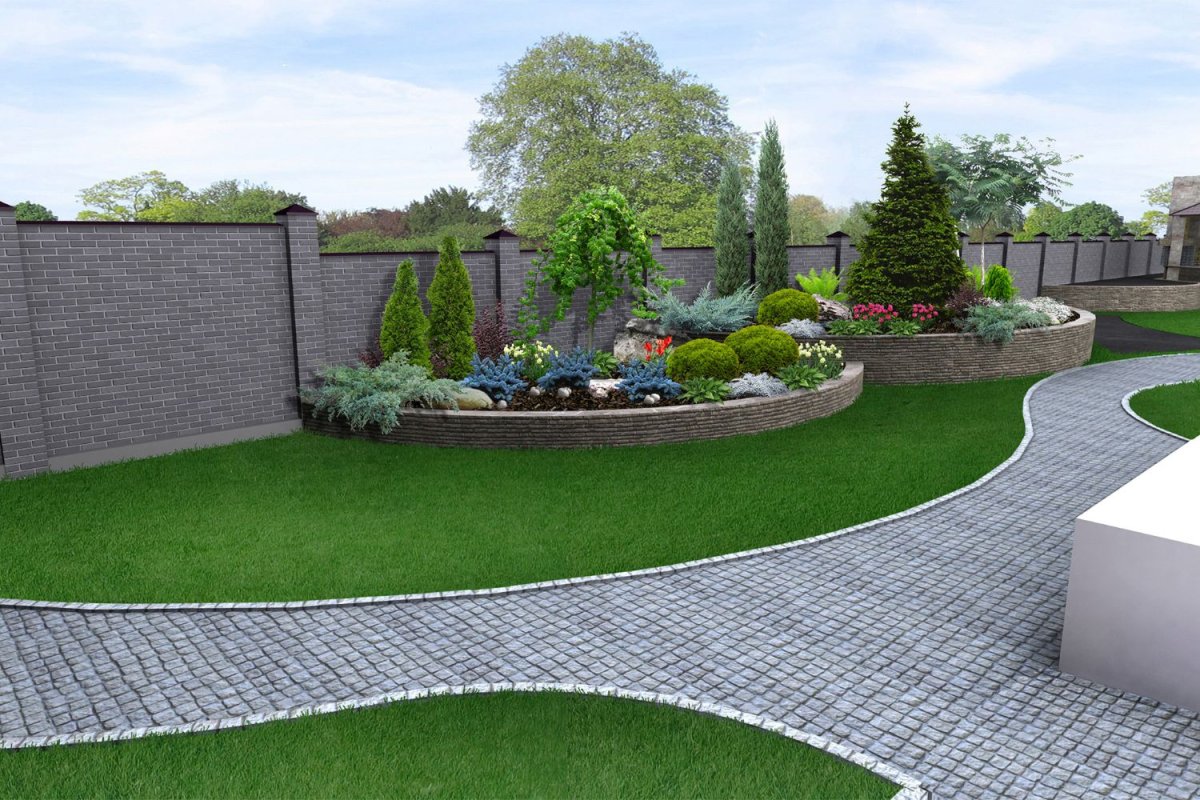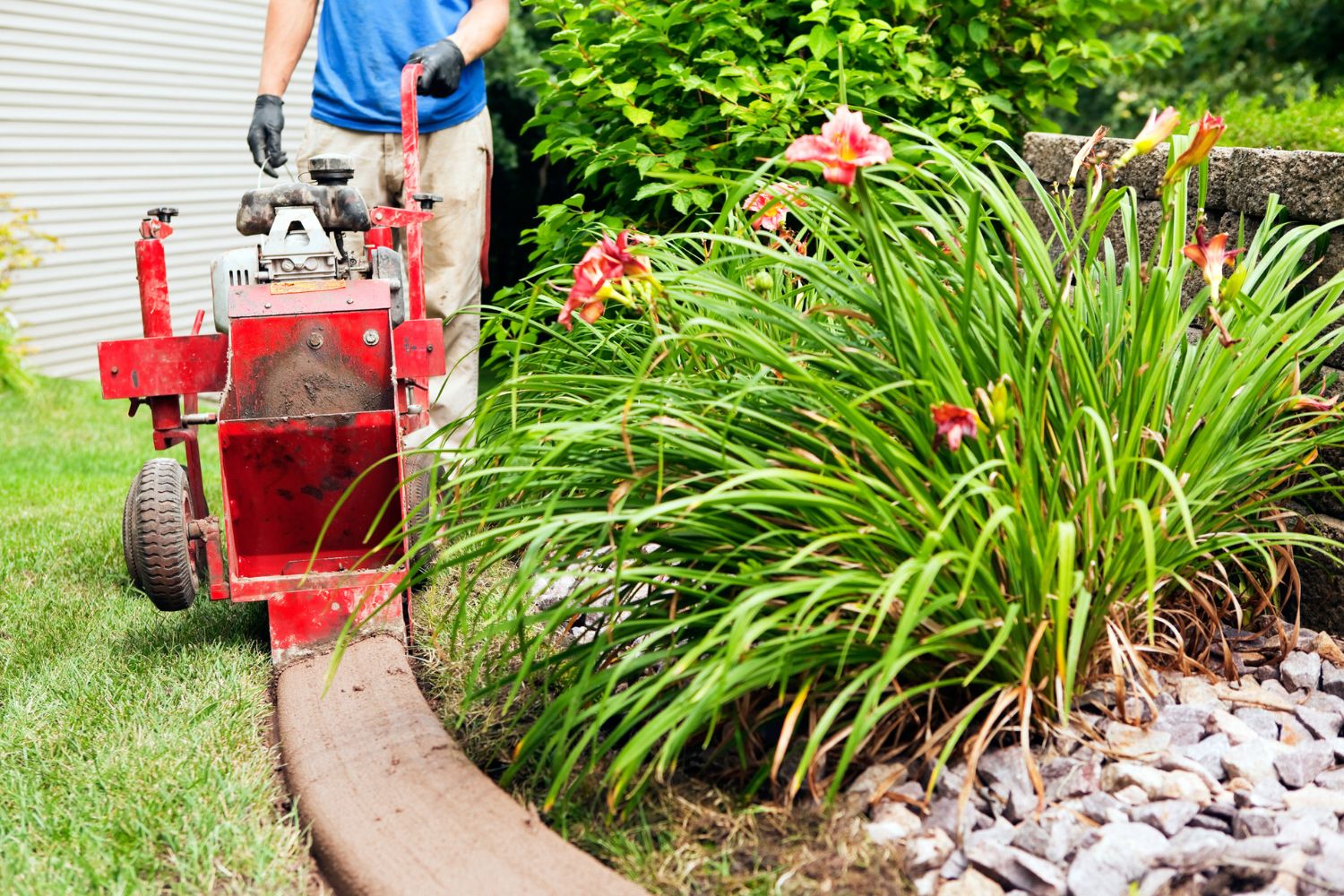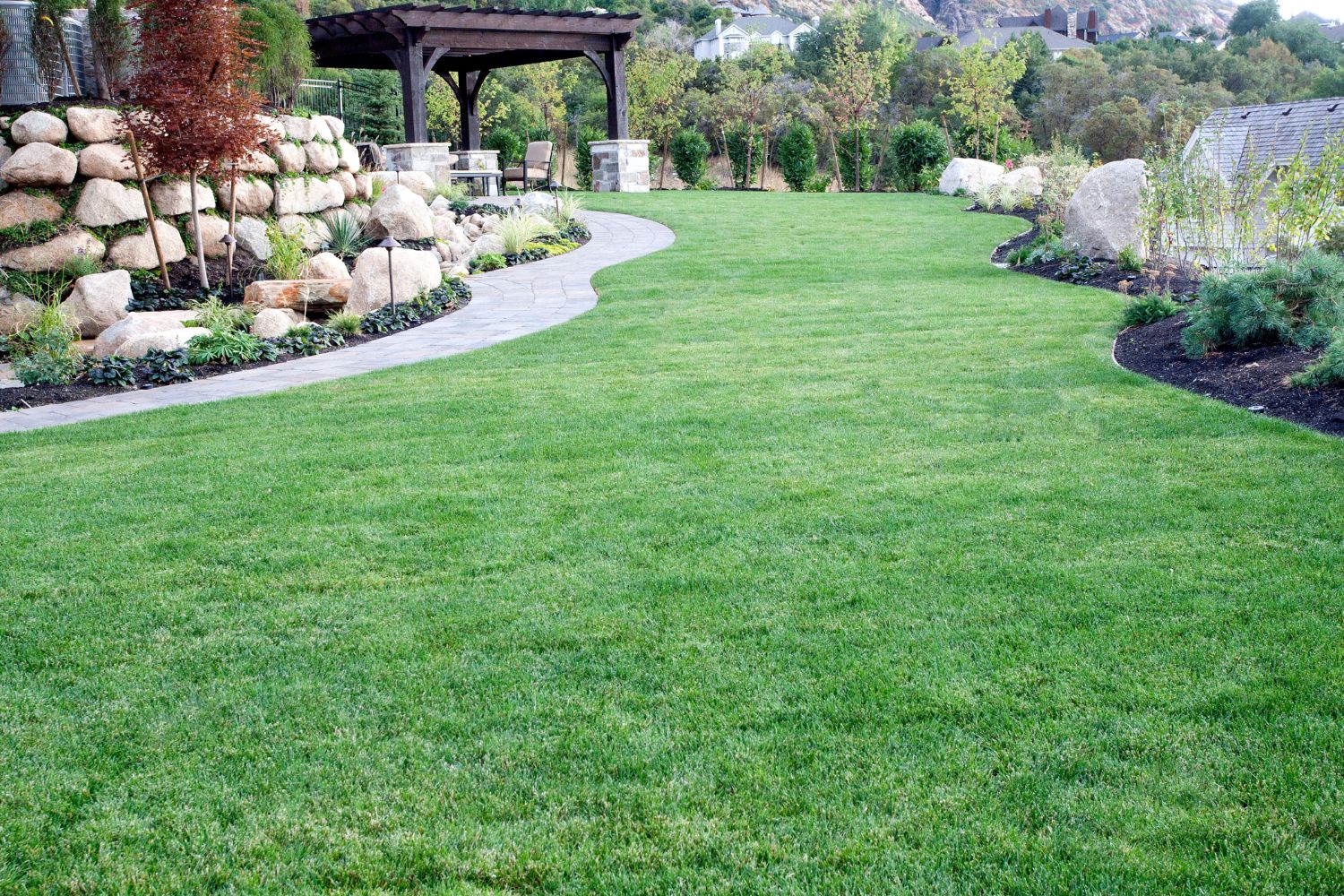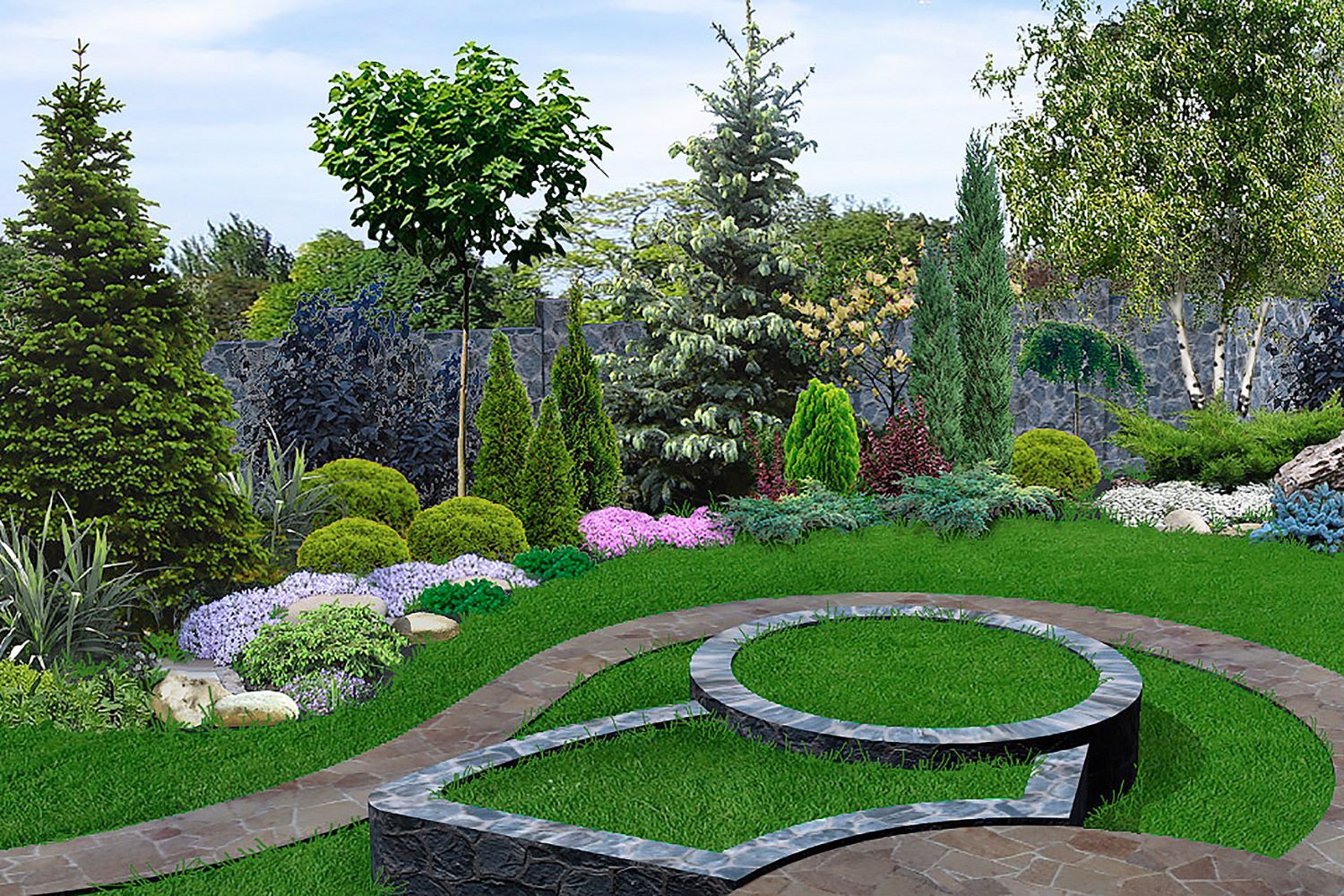

We may earn revenue from the products available on this page and participate in affiliate programs. Learn More ›
Highlights
- Landscape curbing costs between $779 and $2,097, but many homeowners spend an average of $1,401.
- The cost of landscape curbing is dependent on the total linear footage, type of material, project complexity, current labor rates, and many other factors.
- Adding landscaping curbing can enhance a property’s value while also creating a visual and root barrier. It also allows for easier lawn maintenance.
- Designing, preparing, and installing landscape curbing is much more challenging than might be expected. Homeowners typically prefer to leave this project to a pro who is experienced and comfortable doing intensive labor on their knees.
Much in the way a frame enhances a beautiful work of art, landscape curbing or edging can surround a home’s lawn and garden and draw attention to the vivid flowers and manicured shrubs within the borders. Often taken for granted, landscape curbing is an eye-catching way to enhance landscaping and boost a home’s curb appeal. It also serves functional purposes, making lawn maintenance easier, protecting flower beds from water runoff, and reducing the encroachment of grass in the garden beds.
Landscape curbing can be made from a variety of materials including concrete, granite, or plastic. When homeowners are considering whether to add curbing and how to do it, a number of important factors can impact the overall budget. According to Angi, landscaping curbing cost ranges between $779 and $2,097, with the national average being $1,401. The price range varies depending on how much curbing is installed and how complex the project is.

Key Cost Factors
The cost of installing landscape curbing varies depending on several key factors. These include details such as total linear footage, type of material used to construct the curbing, soil conditions at the property, how complex the project is, where the property is located, and the contractor’s labor fees. Homeowners will want to consider these factors when determining a budget for a landscape curbing installation.
Linear Footage
The amount of curbing needed has a major impact on the total cost. Landscape curbing is typically priced by linear foot, and the cost of labor and materials often ranges from $15 to $20 per linear foot. Homeowners can estimate an average of $18 per linear foot for a variety of installation locations.
| Type of Curbing Project | Total Area | Average Cost (Materials and Labor) |
| Concrete patio (12 by 12 feet) | 50 linear feet | $900 |
| Driveway edging | 75 linear feet | $1,350 |
| Front of house | 100 linear feet | $1,800 |
| Garden or flower bed | 30 linear feet | $540 |
| Tree ring | 10 linear feet | $180 |
Material Type
Landscape curbing comes in a wide range of materials, each with different costs, lifespans, design flexibility, and aesthetic value. The most costly option is granite, with a price tag between $20 and $33 per linear foot. Cheaper curbing materials include plastic at $0.50 and $3.25 per linear foot, and brick at $2 to $4 per linear foot. There are also more artistic options, such as galvanized or stainless steel, which start at $2.50 per square foot, and stone, which starts at $12 per linear foot.
Soil Conditions
Before a homeowner installs landscape curbing, it’s important to test the soil on the property. Soil tests usually run between $20 and $75. The results regarding pH levels and nutrient levels can help determine if the soil is in the right condition to support curbing. If testing indicates poor soil conditions, this can cause ground shifting in the future, which will affect the clean, manicured look curbing helps provide. That also means the curbing will have to be replaced, costing additional money.
Project Complexity
The complexity of the curbing design can increase the total cost of the project. For example, straight lines and right angles are cheaper to plan and install than curved edges or complex patterns. A contractor may need to grade a sloped area prior to adding curbing, which will also raise the price. It will cost more to add curbing to homes and properties that have elaborate features like fountains, statues, winding pathways, and uniquely shaped gardens.
Labor
Finding the right professional team to get the job done effectively and efficiently is key, but that comes with labor costs on top of materials. Homeowners can expect to pay between $1.50 to $10 per linear foot, or around $30 to $110 per hour, to hire a professional landscaping company to install curbing. These rates can fluctuate depending on geographic location, the contractor’s experience, and the complexity of the job.
Though the labor rates can be a deterrent for the most cost-conscious homeowners, a pro knows how to make concrete garden edging for a beautiful result in a matter of hours. On the other hand, it can take a busy homeowner several days to complete the job.
Geographic Location
The geographic location of a home can impact the cost of concrete curbs. Large metropolitan areas like Los Angeles and New York City often have higher overall costs than smaller towns. However, even in suburban or rural areas, local building codes and homeowners association (HOA) restrictions can influence what contractors charge. Plus, the cost of materials and equipment can vary depending on location, especially if items need to be shipped farther distances. Homeowners can estimate potential landscape curbing costs by reviewing averages for several cities across the country.
| City and State | Average Cost (Materials and Labor) |
| Boston, Massachusetts | $1,500 to $4,100 |
| Chicago, Illinois | $900 to $3,200 |
| Dallas, Texas | $750 to $1,600 |
| Denver, Colorado | $954 to $1,804 |
| Detroit, Michigan | $1,099 to $2,900 |
| New York City, New York | $1,300 to $3,100 |
| San Francisco, California | $730 to $1,400 |
| Seattle, Washington | $600 to $1,100 |
| Tampa, Florida | $660 to $1,400 |
Additional Costs and Considerations
When planning for the cost of concrete curbing, homeowners will want to factor in any additional costs and considerations, such as existing curbing removal, curb cutting, landscape design services, and supplemental landscaping projects.
Existing Curbing Removal
Homeowners who already have concrete curbing on their property will need to remove it before replacing it with new materials. The cost of removing existing curbing will depend on the type of curbing, thickness, condition, and location. A pro can provide an estimate for removal.
Curb Cutting
If a paver walkway or driveway needs to be connected to the sidewalk or public road, then curb cutting will be a necessary step in the installation process. The process of curb cutting essentially creates a concrete apron or ramp. This allows for excess drainage and lowers the curb’s height for a safer step. Homeowners can expect to pay $4 to $10 per square foot or $1,000 to $1,600 to curb cut a space for a 2-car driveway, depending on the materials used and the total size of the area.
Landscape Design Services
Many homeowners find it’s best to hire a landscape designer for more complex and artistic landscape curbing designs. Designs that curve, have complex patterns, or are made with multiple layers of stone will involve more planning and prep work. Additionally, special tools are required to lay curved curbing. In addition to hiring a pro who can design the curbing, homeowners may be interested in other landscaping design services, such as help with deciding which types of plants and trees to use and trees to use and how to ensure adequate water supply to them. Homeowners can ask a local landscaper how much landscaping costs in their area to get an accurate estimate.
Additional Landscaping Projects
There are several additional landscaping projects that may arise during the process of installing landscape curbing, and each comes with a separate price tag. Sod replacement may be necessary if the curbing project damages some parts of the lawn. This can run from $0.86 to $1.75 per square foot.
Regrading or land leveling costs $0.40 to $2.00 per square foot depending on yard size and slope. Finally, curb sealant, which slows the curing process to prevent cracking or damage, costs $0.50 to $1.00 per linear foot. Other types of landscaping projects include mowing, fertilization, aeration, landscape lighting installation and pond installation. Homeowners can ask the best lawn care services, such as TruGreen and Lawn Love, about their fees for lawn maintenance.
Cost by Type of Material
With the many different types of curbing materials available to choose from, homeowners may need some guidance to determine the best option for their property. A professional landscaper can provide clarity about landscape curbing materials that are ideal for certain design styles, soil types, and climates.
Each type of curbing material has its own cost, lifespan, design flexibility, and aesthetic value. From concrete to plastic to granite and more, here is the breakdown of the characteristics and prices of each material to help homeowners make the best decision based on need and budget.
|
Type of Curbing Material |
Average Cost (Materials Only) |
|
Belgian block |
$9 to $11 per foot |
|
Brick |
$2 to $3 per square foot |
|
Concrete blocks |
$2 to $3 per square foot |
|
Decorative concrete |
$3.50 to $8.50 per linear foot |
|
Granite |
$11 to $16 per linear foot |
|
Plastic |
$0.50 to $3.00 per linear foot |
|
Poured concrete |
$4 to $5 per square foot |
|
Rubber |
$2 to $4 per linear foot |
|
Steel |
$2 to $6 per linear foot |
|
Stone |
$3 to $18 per linear foot |
|
Wood |
$4 to $9 per linear foot |
Belgian Block
Belgian block—a generic term used to describe large blocks of stone—is an attractive option for landscape curbing. It comes in either cubes or rectangular pieces that are often rough hewn for a natural look. Typically made of granite, Belgian block can boost curb appeal. This type of material costs about $9 to $11 per foot.
Brick
As one of the more cost-effective options, brick edging offers a timeless yet rustic look for flower beds, patios, driveways, and garden walkways. The cost ranges from $2 to $4 per square foot, plus $5 to $10 per square foot for labor and installation. Brick is durable, typically lasting from about 10 to 20 years. A variety of colors and textures are available beyond the traditional red brick hue.
Concrete Blocks
Prefabricated concrete blocks have the lowest concrete landscape edging cost of $2 to $3 per square foot, plus $5 to $10 per square foot for labor and installation. Concrete blocks offer design flexibility since the sectional design allows the blocks to be reconfigured even after installation. This material is also quite durable, lasting from 10 to 30 years. However, it is challenging to achieve smooth curves or complex patterns since the blocks are precast.
Decorative Concrete
For a more custom look, homeowners may prefer decorative concrete, also known as stamped concrete. Specialized stamps and colors are applied to poured concrete curbing to create eye-catching designs. Decorative concrete can be stamped to mimic brick, stone, wood, slate, cobbles, or even fossils. Textured concrete is also available with grooves, patterns, stencils, or engravings. If a homeowner prefers a pop of color, installers can also offer a variety of different colors and marbling effects. Decorative or stamped concrete edging costs $3.50 to $8.50 per linear foot for materials only.
Granite
With a materials price tag between $11 and $16 per linear foot, granite is a more luxurious landscape curbing choice. Labor and materials can run between $20 and $33 per linear foot. Since granite has a natural appearance that can lift the look of an outdoor space, this is an investment that offers elegance and durability. It also can withstand harsh weather conditions and usually lasts 30 years or longer with no maintenance required.
Plastic
Plastic is a great option for those who prefer to spend as little as possible up front. Priced at $0.50 to $3.00 per linear foot, plastic edging is easy to install, flexible, lightweight, and resists corrosion and moisture degradation. Still, it’s prone to breaking if crushed by a heavy object and may experience shifting due to stubborn roots.
Poured Concrete
Poured concrete is a popular choice due to its flexibility and smooth appearance. It can easily be molded into curves and corners, which is ideal for more complex terrain. Plus, this material is essentially maintenance-free since it won’t warp or rot. Poured concrete curbing costs from $4 to $5 per square foot for materials, plus $5 to $13 per square foot for labor and installation.
Rubber
For households with young children who frequently play in the yard, rubber is a good option to consider since the material is soft and flexible. Rubber edging costs between $2 and $4 per linear foot depending on the design and thickness of the material.
Steel
A trendy and polished style, steel edging comes in either galvanized or stainless steel finishes. The material is advantageous since it is simple to install, durable, and long lasting—often holding up for 25 to 30 years. The average cost is between $2 and $6 per linear foot, plus $5 to $10 per square foot for installation.
Stone
At $12 to $40 or more per linear foot, stone has a higher price point than some of the other materials, though it includes labor. Materials alone typically cost between $3 and $18 per linear foot. Stonework is often custom, which is partly why it has a higher cost. People often choose stone for its unique beauty and rustic appearance. Softer stones, such as limestone and natural rocks, are less expensive and easier to source, but the more unique and costly varieties, like quartzite, slate, and bluestone, are pricier.
Wood
For a rustic yet luxurious and warm aesthetic, wood offers a natural look for landscape curbing. Material prices range from $4 to $9 per linear foot, but labor adds an additional cost of $5 to $10 per square foot. Prices will vary depending on the wood species used. For instance, pine and cedar are the most reasonably priced options, while exotic hardwoods like Brazilian cherry and Ipe are at the higher end.
There are some limitations to using wood, however. If the design calls for curves, then wood isn’t the best choice since it won’t maintain a curved shape over time. Also, there is a risk of decay, rotting, and termite infestation unless the wood is pretreated or naturally resistant. Treated wood lasts 10 to 20 years, while untreated wood only lasts 3 to 10 years.

Benefits of Installing Landscape Curbing
Besides the clear visual appeal of landscape curbing, there are numerous benefits that boost property value and improve the longevity and function of the landscape. “Implementing well-designed landscape curbing establishes both flow and structure within your garden space,” notes Evan Davis Santi, president of Urban Plantscapes in New York City. “Whether [you opt] for rocks, stone, brick, concrete, or stamped concrete, carefully chosen curbing enhances the overall aesthetic of your property.”
Visual Barrier
Curbing creates a visual barrier, helping to improve the overall tidiness and aesthetics of the garden. The curved concrete edging does an effective job in establishing unique sections of the yard. Trees and flower beds, for example, can be neatly separated by curbing. These delineations can also direct people to designated walking paths, ensuring the garden bed is left undisturbed.
Root Barrier
Installing curbing for landscaping helps to keep plant root growth under control. Without the barrier in place, some garden plants can grow and spread their roots all over the yard. The curbing ensures that the roots grow in an organized manner without constricting them too much.
Easier Lawn Maintenance
Santi says, “Practically speaking, landscape curbing simplifies maintenance tasks, such as weeding and mowing, by clearly defining bed boundaries.” Weeds and grass that tend to creep and shoot up new sprouts will be limited in the ground they can encroach upon. Curbing also reduces trimming time since curbs naturally keep a cleaner line of grass that can be mowed or trimmed.
Improved Curb Appeal
Finally, landscaping curbs help create well-designed landscape borders that appear neat, clean, and well maintained. This enhances the overall look and feel of the yard to ensure that visitors have a positive first impression, which ultimately has the potential to raise the property value of the home. “Ultimately, the investment in landscape curbing significantly boosts curb appeal, making a substantial difference in the visual allure and perceived value of your property,” explains Santi. “Landscape curbing contributes to increased property values by adding a polished and cohesive look to your outdoor environment.”
DIY vs. Hiring a Professional
Homeowners are encouraged to weigh the advantages of hiring one of the best landscaping companies versus the potential cost savings of a DIY project. Installing landscape concrete curbing can be quite labor intensive, so most homeowners opt to hire a professional to handle this type of work. While a handy homeowner may be interested in taking one of the best online landscape design courses so they can learn how to do this type of work themselves, they’ll still need to be aware of the intensity of the job. Carrying heavy stones and bricks can be tiring, as is digging trenches deep enough to secure the blocks, prevent erosion, and block root growth.
According to Dave Marciniak, owner and lead designer at Revolutionary Gardens in Culpeper, Virginia, “Installing landscape curbing using bricks or cobblestones is quite labor intensive, requiring the installer to remove turf, dig a trench, and use concrete or stone dust to keep the individual pieces in place. Pointing up [applying mortar] between the bricks or cobblestones is also labor intensive and takes some skill to look good. If installing extruded concrete curbing, you need to call a pro because of the specialized equipment required.”
Hiring a professional who has the specialized training, experience, and equipment necessary helps ensure that the project gets done correctly without compromising on safety or quality. This can ultimately save homeowners time, stress, and money, along with providing the reassurance that a qualified, knowledgeable team is handling the installation.
How to Save Money
Installing curbing landscaping comes with its own price tag, so homeowners may be interested in learning about tips to save money during this decorative and functional project.
- Shop around. Santi recommends doing some comparison shopping. “Prioritize obtaining quotes from several landscaping companies to gather comprehensive pricing information and service offerings.”
- Bundle services. Homeowners can ask if the contractor will offer a discount if they include other services in addition to landscape curbing.
- Choose materials carefully. The curbing material chosen can dictate the cost of the project. Opting for plastic or concrete curbing for landscaping over pricier alternatives like natural stone or brick can keep up-front costs lower.
- DIY prep work. While it is not recommended to complete the entire curbing project without a professional contractor, homeowners can cut costs by doing some of the prep work themselves. Common tasks could include clearing the area, leveling the land, and/or removing sod.
- Get creative. “Creativity saves money,” concludes Marciniak. “I’ve seen people use 4×4 or 6×6 landscape timbers, urbanite (recycled concrete from walks or patios), or even wine bottles for landscape curbing and edging. Local groups and Facebook Marketplace are places to find free or really inexpensive materials.”
- Embrace simplicity. Simpler designs with straight lines and right angles are cheaper to install than curved patterns.

Questions to Ask a Pro
When considering which local lawn care services can install concrete edging for landscaping, homeowners can ask neighbors and friends for recommendations and read online reviews. They are also encouraged to ask questions when interviewing different landscapers to understand their experience and estimated fees.
- Are you licensed, insured, and bonded?
- Have you completed projects that are similar in size, scope, and design?
- Can you share photos of similar work you have completed?
- Can you provide references?
- What types of materials would you recommend for my property and budget?
- What is the estimated cost of the project?
- What is the projected timeline?
- Who will be on-site?
- How will you protect the rest of my property from damage during installation?
- Who is responsible for any sod that needs to be replaced after the job is completed?
- How will the project impact my usual routine?
- What type of maintenance will be required after the installation?
- Do you offer a warranty?
- Is there anything that can be done to reduce costs?
FAQs
When homeowners are deciding whether to install concrete landscape curbing on their property, it’s helpful to collect as much information ahead of time as possible. They will want to understand what’s included in the costs, how the process works, and how to ensure they get what they envision. The following questions and answers are helpful for anyone considering adding landscape curbing to their yard.
Most concrete curbing and edging lasts about 10 to 30 years, on average. The length of time will vary depending on the specific type of material used and other factors, such as the local climate.
All types of concrete can crack, including curbing used for concrete edging borders. Expert installers may use expansion joints every couple of feet to minimize the chance of cracking. They can also use fiber mesh and other additives to prevent any shrinkage, which is often the cause of cracks. Some installers may provide a warranty against cracks that develop within a certain time frame.
It is recommended to dig about 4 inches deep when installing edging. This helps ensure a strong border between the lawn and garden bed while also providing a good visual line.
The best height for concrete landscape edging is between 3 and 5 inches high. Determining the exact height depends on how much the homeowner wants the bricks or stones to be visible above the soil. It is also recommended to place the edging at least 2 to 4 inches below the soil to ensure stability and contain roots.
It typically takes only a single day to complete a landscape curbing project. However, the timing will depend on the materials used, the complexity of the terrain, and the total linear feet of the area.
While concrete curbing will feel dry after 24 hours, it actually needs 28 days to completely dry and properly cure. It is advised to avoid any activity near with newly installed curbing for at least 2 days, which includes keeping people and animals away from the area.
Angi, HomeAdvisor, HomeGuide, Gardenista, Lawn Love, Courier Journal
